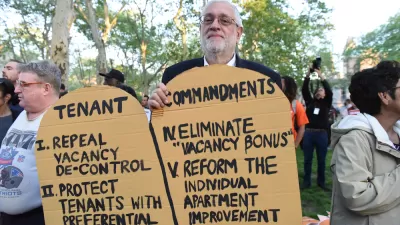Technology is changing the game of real estate in New York City. The technology behind the revolution, called proptech, is only going to become more critical as cities respond to climate change.

Looking for an explanation of the power of "proptech," technology designed to disrupt the real estate industry? Then look no further than New York City, where Crain's New York Business reporter Greg David shows how one real estate company is already putting proptech to work.
David starts the exploration with the example of NANTUM, a cloud-based operating system developed by the Rudin Management Company. Rudin has even created a subsidiary called Prescriptive Data to develop proptech. Examples of NANTUM at work include property managers responding to citywide mandates for temperature regulation across the entire Rudin portfolio, or using the technology to respond to power spikes after a power outage.
Despite the successes of the companies already in the proptech space, the number of traditional real estate companies pushing into proptech "can be counted on one hand," according to David.
New regulations might push NANTUM into the next level of scalability, according to David. "Nantum's biggest opportunity may come from the tough climate-change law passed by the City Council this year requiring a 40% reduction in large building emissions by 2030 and an initial cut by 2024." Proptech will become a necessity in the kind of regulatory environment established by laws like New York's new climate change law, according to sources cited in the article.
The article includes more details about the origins of NANTUM (the 2009 Obama stimulus package) and its partnerships with Con Edison, the utility in New York City.
FULL STORY: Rudin's proptech firm is not your typical startup

Alabama: Trump Terminates Settlements for Black Communities Harmed By Raw Sewage
Trump deemed the landmark civil rights agreement “illegal DEI and environmental justice policy.”

Planetizen Federal Action Tracker
A weekly monitor of how Trump’s orders and actions are impacting planners and planning in America.

The 120 Year Old Tiny Home Villages That Sheltered San Francisco’s Earthquake Refugees
More than a century ago, San Francisco mobilized to house thousands of residents displaced by the 1906 earthquake. Could their strategy offer a model for the present?

In Both Crashes and Crime, Public Transportation is Far Safer than Driving
Contrary to popular assumptions, public transportation has far lower crash and crime rates than automobile travel. For safer communities, improve and encourage transit travel.

Report: Zoning Reforms Should Complement Nashville’s Ambitious Transit Plan
Without reform, restrictive zoning codes will limit the impact of the city’s planned transit expansion and could exclude some of the residents who depend on transit the most.

Judge Orders Release of Frozen IRA, IIJA Funding
The decision is a victory for environmental groups who charged that freezing funds for critical infrastructure and disaster response programs caused “real and irreparable harm” to communities.
Urban Design for Planners 1: Software Tools
This six-course series explores essential urban design concepts using open source software and equips planners with the tools they need to participate fully in the urban design process.
Planning for Universal Design
Learn the tools for implementing Universal Design in planning regulations.
Clanton & Associates, Inc.
Jessamine County Fiscal Court
Institute for Housing and Urban Development Studies (IHS)
City of Grandview
Harvard GSD Executive Education
Toledo-Lucas County Plan Commissions
Salt Lake City
NYU Wagner Graduate School of Public Service





























